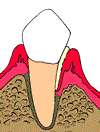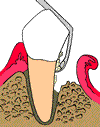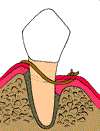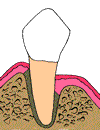So, you have periodontal disease (or gum disease). You have done the recommended scaling and root planning (the deep cleaning with your hygienist) and have upped your home dental care. However, your pocket(s) around your teeth are still deep and contain bacteria. What do you do now? If this situation sounds like you, your dental care provider might recommend a periodontal pocket reduction procedure, also known as osseous surgery.
A periodontal pocket reduction procedure can be done by either your family general dentist or a periodontist (a gum specialist). The procedure is done in areas where the bacteria is too deep for at home care or a deep cleaning by a professional hygienist to reach. In order to get your gums back to a more natural and healthier state, removing the bacteria is key!
How do dentists and periodontists get deep enough to get this bacteria? During the procedure, your dental provider will flap, or fold back your gums so your roots are exposed and all the disease causing bacteria can be removed. If the bone underneath the bacteria has been damaged, your dental provider can smooth away any irregular surfaces so you will have a healthier tooth for your gums to reattach to. While it may sound scary, the pocket reduction procedure is a very common periodontal approach. And when all is said and done, it is a very successful procedure!
What are some of the side effects of the pocket reduction procedure? The good news is, side effects are very minimal for most patients. Potential side effects are:
- Bleeding: Mild to moderate bleeding is normal after the procedure.
- Swelling: Swelling is common after surgery for the first few days. Applying an ice pack to the swelling is often the best solution.
- Discomfort: Discomfort is expected with any surgical procedure both in and out of the dental office. Listen to your dental provider for pain. Some cases are controlled via over the counter medications, some may need a prescription.
- Bruising: Bruising is possible in the gums, lips,neck and cheeks depending on the patient and their body reactions.
- Sutures: After your procedure, your gums will be sutured back together. Depending on the case, your sutures are either dissolvable or not. Either way, prepare to have those sutures for about two weeks.
After your surgery, some patients are given a prescription of antibiotics to take to prevent the possibility of an infection. Your dental team will go over care with you before you leave the office but here are a few things to remember after your procedure:
- Hygiene: Your doctor may prescribe an antibacterial mouthwash to help with healing and prevent infection. Make sure to use as directed. Continue brushing your teeth as normal outside of the surgical site. Follow the instructions for the surgical area and make sure you are very gentle to avoid any trauma.
- Smoking: You should not smoke for at least two weeks as tobacco has been proven to have a negative effect on healing.
- Alcohol: Alcohol should not be consumed for at least 24-48 hours after the procedure.
- Diet: For the next two weeks you will want to try and stick with a soft diet. Some good ideas are:
-
- Applesauce
- Yogurt
- Soups
- Cooked Pasta
- Oatmeal
- Mashed potatoes
- Scrambled eggs
- Pudding
- Jell-O
- Etc
-
What happens if I choose not to have the pocket reduction procedure? If not cleared out appropriately, these deeper pockets collect more bacteria, which leads to the destruction of the bone. If untreated long enough, there is also the possibility of permanently loosing your tooth. If the bone is too destroyed due to the bacteria, you may no longer be a candidate for dental implants to replace the tooth.
If you are thinking you may need pocket reduction, give Dr. Fattahi and the staff at Hamilton Dental Group a call! They will get you scheduled with Dr. Fattahi to see if you do indeed need the procedure and can even give you an estimate for your out of pocket!
 |
Normal, healthy gums have small pockets around each tooth. The bacteria and infection associated with periodontitis causes these pockets to become deeper, trapping more bacteria and causing more infection. When the pockets become too deep for scaling and root planing, a Pocket Depth Reduction procedure is often a solution. |
| During a Pocket Depth Reduction procedure,Dr. Fattahigently folds back the gum and removes the disease-causing bacteria and infection. |
 |
 |
Dr. Fattahiwill then smooth the root surfaces and, if necessary, reshape the gum and bone. |
| This will allow the gums to form smaller, healthier pockets. |
 |



